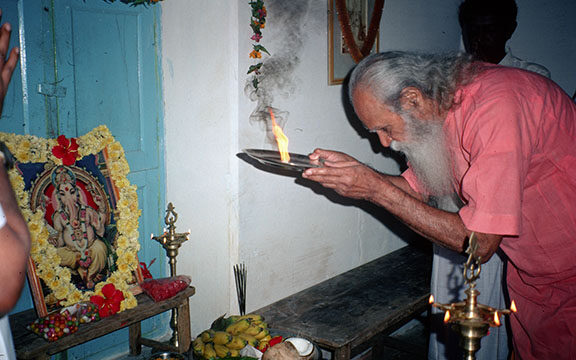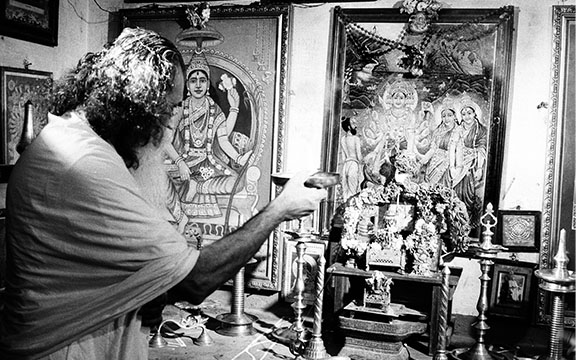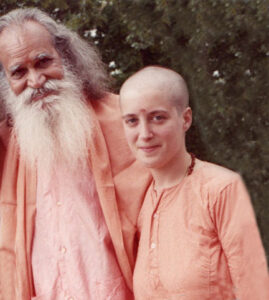
Photo: Swami Satchidananda offering camphor arati to Lord Ganesha, India, early 1990s.
Devotion and worship were part and parcel of Ramu’s (Swami Satchidananda’s birthname was Ramaswamy, Ramu for short) upbringing and shaped him, his daily life and worldview. His parents were extremely devout and raised Ramu to participate fully in traditional spiritual practices. Ramu’s childhood was filled with devotional rituals.
He would walk before dawn each to a farm one and a half miles from the house. An acre of land there was set aside for use as a flower garden. Brightly colored flowers of particular beauty grew here for use in the family puja room where devotional worship was conducted for the family by his father, Sri Kalyanasundaram.
Ramu would jump into the farm irrigation well to wash and then he would change into fresh clothes before picking flowers for the daily pujas. After bringing the flowers into the house, he would sit outside and make sandalwood paste, rubbing chandan (sandalwood) against a stone and mixing it with water. Chandan paste is believed to have purifying properties and by applying it to the forehead, neck, or other parts of the body, devotees cleanse their thoughts and intentions before approaching the God. Chandan is also a part of daily puja because of its cooling effect on the skin. In the hot climate of South India, it offers a refreshing and calming sensation to aid devotees in concentrating on their prayers and meditation. Chandan is also offered to the deity being worshipped as it is considered a sacred substance and a gesture of love and reverence to the deity.
“Meditation is food for the soul. When I was a boy, sometimes I would sleep a little late in the morning and rush in for breakfast.
My mother would ask, ‘Did you meditate?’ When I told her that I had not meditated, she would say, ‘Meditation is more important food than breakfast.
If you miss your breakfast, you will eat your lunch well! But never miss your meditation.’ How fortunate I was to have a mother like that.
We learn many great things from our own parents if they themselves have that kind of understanding.” –Swami Satchidananda
Ramu would enter the puja room to watch his father perform the worship. The room was fairly large. It had a high ceiling and was covered with various images of the Hindu deities who were regularly worshipped in Tamil Nadu. There was a stone Shiva Lingam, the formless form of Lord Shiva and a statue of Lord Ganesh, the son of Lord Shiva and Parvathi.
The Shiva Lingam holds deep spiritual significance in Hinduism and is considered a powerful symbol of cosmic energy and the divine presence of Lord Shiva. The Shiva Lingam is typically a cylindrical or oval-shaped stone, often with markings or carvings on it. Devotees believe that the lingam represents the infinite nature of Lord Shiva, as well as his transcendental formless aspect, which is beyond human comprehension.
Worship of the Shiva Lingam involves various rituals, including offering flowers, water, milk, chandan, vibhuti (holy ash), and other substances, as well as chanting prayers and mantras. It is believed that by worshipping the lingam with devotion and purity, one can attain spiritual enlightenment and moksha (liberation).
Lord Ganesh is worshipped as the remover of obstacles and the bestower of wisdom. Devotees often pray to him before starting any new endeavor or undertaking, seeking his blessings to overcome obstacles and challenges in life. He is also regarded as the god of wisdom, intellect, and knowledge. His large elephant head symbolizes his vast intelligence and wisdom. He is believed to bestow blessings upon his devotees to excel in academics, arts, and other intellectual pursuits. In Hindu rituals and ceremonies, he is invoked at the start of any endeavor to ensure its success and prosperity. Ganesh has a broken tusk that is symbolic of non-attachment to worldly desires. It signifies the importance of sacrificing one’s egoistic desires in the pursuit of spiritual growth.
Ganesh is often seen as a symbol of unity in diversity. His form combines elements from both animal and human realms, representing the harmony and interconnectedness of all existence, a principle that will become a guiding light for Ramu throughout his life.

Photo: Sri Swamiji worshiping the main deity in the family puja room during a visit to his birthplace, Chettipalayam, India, early 1970s.
The main family deity was a large, framed relief of Lord Subramanya. The deity was flanked by his consorts, the Goddesses Valli and Devayani. All were dressed in richly draped cloths and ornamented with real jewels embedded into the relief—both precious stones and artificial ones that formed tiaras, earrings, necklaces, and shining bracelets. Even the Lord Subramanya’s Vel (spear) was dotted with stones.
Lord Subramanya (also known as Murugan, Skanda, Kartikeya, or Shanmukha) is Lord Ganesh’s brother, being the other son of Lord Shiva and Goddess Parvati, and he is an important deity within the Tamil tradition. He is revered for his valor, wisdom, and divine attributes. His spiritual significance is very profound. He is often depicted as a warrior deity who vanquishes evil forces and protects his devotees from harm. His Vel symbolizes the power to pierce through ignorance and obstacles on the spiritual path. Devotees pray to him for strength and courage to overcome challenges and adversities in life.
Without a doubt, Ramu’s participation in the daily worship of this deity played a significant role in his life and spiritual journey. Lord Subramanya is associated with spiritual growth and evolution. His worship is believed to bestow devotees with wisdom, knowledge, and inner strength to progress on the spiritual path, overcome the ego, and attain spiritual liberation.
In the worship of this deity, we find that message of the unifying force that brings together various aspects of existence. Lord Subramanya’s six faces (Shanmukha) symbolize the interconnectedness of the shad gunas (six attributes) of God: Jnana (wisdom), Vairagya (dispassion), Bala (strength), Kirti (renown), Sri (abundance), and Aishwarya (sovereignty).
The Divine Feminine in the Tamil Shaiva Tradition as represented by Goddess Valli and Goddess Devayani personify two of the three aspects of the Divine Shakti, the divine feminine energy that drives the universe. Goddess Valli represents the Iccha Shakti (power of the will) and Goddess Devayani represents Kriya Sakti (power of action). The third Shakti, Jnana Shakti (power of knowledge), is represented by the Vel that Lord Subramunya holds.
At the end of each puja, Ramu’s father would perform an arati, offering camphor light to the deity. The piece of camphor is solid but when lit, it dissolves completely in the fire’s flame, leaving not a trace. By offering camphor arati, the devotee symbolically offers their ego to God and the result is the dissolution of the sense of a separate self and the experience of the oneness of all.
Ramu’s exposure to and immersion in these sacred traditions all helped to inspire him in the nondual understanding which highlights the underlying unity behind all the diversity. This recognition will play a major role in Ramu’s transformation into Swami Satchidananda—the renowned spiritual leader who promoted the nondual understanding through his Yoga teaching and in his advocacy as the interfaith visionary he became.
Find previous installments here: Part 1, Part 2
About the Author:
 Swami Premananda, Ph.D. is a senior disciple of Sri Gurudev Swami Satchidananda and served as his personal and traveling assistant for 24 years. Her interest in the study of the spiritual roots of the Integral Yoga tradition and lineage was inspired over many years of traveling with Sri Gurudev to the various sacred sites throughout India that are a part of this tradition. She also undertook a 2-year immersion into the nondual Saiva Yoga Siddhar tradition that is at the heart of Sri Gurudev’s spiritual roots. She further studied the history, sacred texts, and teachings of Tamil Saivism including the Siddhars, bhakti poet saints, as well as the spiritual luminaries who lived in the 19th – 20th centuries and who inspired Sri Gurudev, such as Sri Ramana Maharshi, Swami Ramdas, and Swami Vivekananda. She serves as editor of Integral Yoga Magazine, Integral Yoga Publications; senior archivist for Integral Yoga Archives; and director of the Office of Sri Gurudev and His Legacy.
Swami Premananda, Ph.D. is a senior disciple of Sri Gurudev Swami Satchidananda and served as his personal and traveling assistant for 24 years. Her interest in the study of the spiritual roots of the Integral Yoga tradition and lineage was inspired over many years of traveling with Sri Gurudev to the various sacred sites throughout India that are a part of this tradition. She also undertook a 2-year immersion into the nondual Saiva Yoga Siddhar tradition that is at the heart of Sri Gurudev’s spiritual roots. She further studied the history, sacred texts, and teachings of Tamil Saivism including the Siddhars, bhakti poet saints, as well as the spiritual luminaries who lived in the 19th – 20th centuries and who inspired Sri Gurudev, such as Sri Ramana Maharshi, Swami Ramdas, and Swami Vivekananda. She serves as editor of Integral Yoga Magazine, Integral Yoga Publications; senior archivist for Integral Yoga Archives; and director of the Office of Sri Gurudev and His Legacy.

